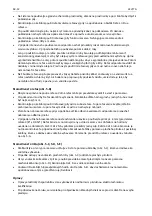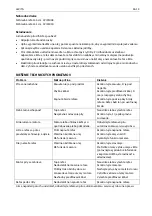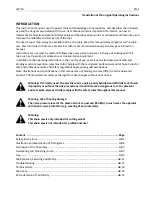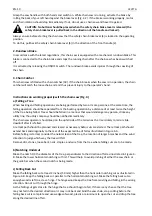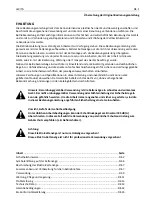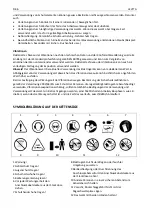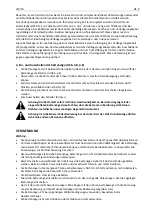
EN
‐
10
LEVITA
Grasp
the
saw
handle
with
both
hands
and
switch
on.
While
chain
saw
is
running,
activate
the
brake
by
rolling
the
back
of
your
left
hand
against
the
brake
lever
(Fig.
3
‐
C).
If
the
brake
is
working
properly,
motor
and
chain
rotation
should
stop
immediately.
If
not,
do
not
use
a
chain
saw
and
have
it
repaired.
CAUTION:
No
buttons
should
be
pressed
when
the
safety
chain
brake
lever
is
released
(the
safety
chain
brake
lever
is
pulled
back
in
the
direction
of
the
handle
and
locked).
Always
ensure
before
starting
the
chain
saw
that
the
safety
chain
brake
lever
(4)
is
locked
in
the
operating
position.
To
do
this,
pull
back
the
safety
chain
brake
lever
(4)
in
the
direction
of
the
front
handle
(2).
2.
Rundown
Brake
In
accordance
with
the
latest
regulations,
this
chain
saw
is
equipped
with
a
mechanical
rundown
brake.
This
brake
is
connected
to
the
chain
brake
and
stops
the
running
chain
after
the
chain
saw
has
been
switched
off.
It
is
activated
by
releasing
the
ON/OFF
switch.
The
rundown
brake
avoids
injuries
through
the
coasting
of
the
chain.
3.
Chain
Catcher
This
chain
saw
is
fitted
with
a
chain
catcher
(18).
If
the
chain
breaks
when
the
saw
is
in
operation,
the
chain
catcher
will
catch
the
loose
chain
end
and
thus
prevent
injury
to
the
operator‘s
hand.
Instructions
on
working
properly
with
the
chain
saw
(Fig.
4)
a)
Felling
a
Tree
When
bucking
and
felling
operations
are
being
performed
by
two
or
more
persons,
at
the
same
time,
the
felling
operation
should
be
separated
from
the
bucking
operation
by
a
distance
of
at
least
twice
the
height
of
the
tree
being
felled.
Trees
should
be
felled
in
a
manner
that
would
endanger
any
person,
strike
any
utility
line,
the
utility
company
should
be
notified
immediately.
The
chain
saw
operator
should
keep
on
the
uphill
side
of
the
terrain
as
the
tree
is
likely
to
roll
or
slide
downhill
after
it
is
felled.
A
retreat
path
should
be
planned
and
cleared
as
necessary
befor
cuts
are
started.
The
retreat
path
should
extend
back
and
diagonally
to
the
rear
of
the
expected
line
of
fall
as
illustrated
in
Figure
4
‐
A.
Before
felling
is
started,
consider
the
natural
lean
of
the
tree,
the
location
of
larger
branches
and
the
wind
direction
to
judge
which
way
the
tree
will
fall.
Remove
dirt,
stones,
loose
bark,
nails,
staples,
and
wire
from
the
tree
where
felling
cuts
are
to
be
made.
b)
Notching
Undercut
Make
the
notch
1/3
the
diameter
of
the
tree,
perpendicular
to
the
direction
of
fall
as
illustrated
in
Figure
4
‐
B.
Make
the
lower
horiziontal
notching
cut
first.
This
will
help
to
avoid
pinching
of
either
the
saw
chain
or
the
guide
bar
when
the
second
notch
is
being
made.
c)
Felling
Back
Cut
Make
the
felling
back
cut
at
least
2
inches
(50
mm)
higher
than
the
horizontal
notching
cut
as
illustrated
in
Figure
4
‐
B.
Keep
the
felling
back
cut
parallel
to
the
horizontal
notching
cut.
Make
the
felling
back
cut
so
enough
wood
is
left
to
act
as
a
hinge.
The
hinge
wood
keeps
the
tree
from
twisting
and
falling
in
the
wrong
direction.
Do
not
cut
through
the
hinge.
As
the
felling
cut
gets
close
to
the
hinge
the
tree
should
begin
to
fall.
If
there
is
any
chance
that
the
tree
may
not
fall
in
the
desired
direction
or
it
may
rock
back
and
bind
the
saw
chain,
stop
cutting
before
the
felling
back
cut
is
complete
and
use
wedges
of
wood,
plastic
or
aluminum
to
open
the
cut
and
drop
the
tree
along
the
desired
line
of
fall.
Summary of Contents for 160 ES
Page 2: ...i...
Page 3: ...ii...
Page 5: ...iv...
Page 6: ...v...
Page 22: ...CZ 16 LEVITA...
Page 38: ...SK 16 LEVITA...
Page 54: ...EN 16 LEVITA...

